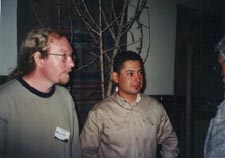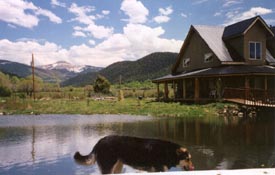 |
|
|
Volume VI |
May/June 2001 |
Number V |
|
|
A Who's Who at the April 27-28 Collaborative Stewardship "Unconference"ANNOUNCEMENTSPutting Water to Beneficial Use By Kay Matthews Editorial: Maintaing Rural Communities in the Face of Development By Mark Schiller |
Editorial: Collaborative Stewardship - Where Do We Go From Here? By Kay Matthews Book Review By Kay Matthews The New Ranch: A Guide to Restoring Western Rangelands By Nathan F. Sayre Op Ed: Lawsuit Filers Hurting Environmental Cause By Les Crowder and Tom Delehanty Rocky Mountain Youth Corps at Work in El Valle By Kay Matthews |
A Who's Who at the April 27-28 Collaborative Stewardship "Unconference"
Cecilia Seescholtz

George Grossman
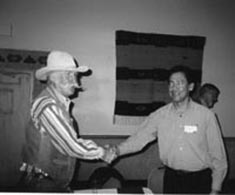
Crockett Dumas and Estevan Lopez
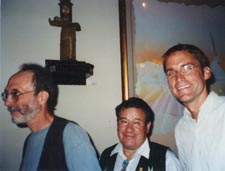
Mark Schiller, Max Cordova, Jake Kosek
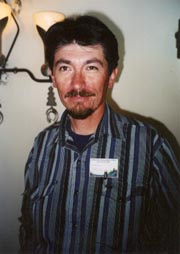
Virgil Trujillo
ANNOUNCEMENTS• The Peñasco Community Center will hold its annual meeting to elect a board of directors on Monday, June 11 at 7:00 pm. Everyone is invited to attend. • Sheep is Life - A Celebration of Sheep, Wool, and Weaving, will be presented by Diné bé'iiná, Inc.(The Navajo Lifeway) at Diné College, Tsaile, Arizona, Navajo Nation, on June 18-23. There will be free events for the public on Friday and Saturday, June 22-23 from 9:00 am to 6:00 pm at the traditional Shade House and Sheep Camp on the Diné College campus. These include demonstrations on cheese making, certification, history, and sheep dog training. Other activities include a sheep show with trophies, roundtable discussions, and hayrides into Canyon de Chelly Workshops will be held Monday through Friday, June 18-22, on weaving dyeing, felting, and more. For more information, or to register for the workshops, contact Suzanne Jamison at 505-536-9339 or Joan Thompson, 520-755-6448. The web site address is: www.recursos.org/sheepislife. The e-mail address is: sznjmsn@gilanet.com. The mailing address is: Sheep is Life, Diné bé'iiná, Inc., P.O. Box 539, Ganado, AZ 86505. • The Camino Real Ranger District of Carson National Forest is proposing the Angel Fire Wildland Urban Interface Project (WUI) to produce a healthy ecosystem and reduce the risk of catastrophic fire. Wood products may also be provided to the surrounding communities. The analysis area consists of approximately 2,500 acres west and south of Angel Fire. The proposed fuel breaks within the analysis area total approximately 12 miles or 400-600 acres and broadcast burning, once the fuelbreaks are complete, would total approximately 300 acres. The project is expected to take 5 years to complete. A Biological Assessment and Evaluation will be completed for the area before a final decision is made by the District Ranger. If you have concerns or comments about the proposed project you may contact the Camino Real Ranger District at P.O. Box 68, Peñasco, NM 87553, 505-587-2255.
• The Camino Real Ranger District of Carson National Forest is soliciting public input regarding the request by Rio Grande Forest Products for a temporary two year road use permit for 2 miles of Forest Road 639 and 667. Rio Grande wants to transport approximately 2 MMBF (2 million board feet) of timber that it will be harvesting from the Truchas Land Grant across these forest roads. Road improvements would include the replacement of two culverts, the placement of barrow material on the road, and intermittent road blading. The roads are located above the village of Truchas adjacent to the grant lands. The request for permit falls under the direction for Categorical Exclusions. If you have comments or questions you may contact the Camino Real Ranger District at P.O. Box 68, Peñasco, NM 87553, 587-2255. Putting Water to Beneficial UseBy Kay MatthewsWater conservation is on everyone's mind these days, but acequia parciantes get very suspicious when folks from urban areas or public officials start talking about how farmers should be conserving water: lining acequias with concrete, metering, water delivery systems, etc. What farmers read between these lines is an agenda whose goal is to make it easier to transfer water to growing urban populations and industrial and recreational development, not to provide parciantes with their actual appropriated rights. This is not to say that farmers aren't interested in traditional and innovative methods for efficient delivery of water to their gardens, orchards, and fields. Jacobo Romero, an El Valle parciante who was featured in Bill deBuys book River of Traps, was the consummate flood irrigator who knew how to get water to every square inch of his fields. Parciantes have often terraced their land to prevent flooding and over watering. Other parciantes use holding ponds fed by the acequia to store water for use in gardens, which require more frequent watering than the one- or two-week rotations for hay fields and orchards. One farmer in El Valle pumped water from his pond to a drip irrigation system, which he used to water his extensive crops of vegetables and grains. The Lopez family of Llano Largo uses holding ponds out of necessity for flood control. The ponds, which Terry Lopez doesn't like to refer to as "holding" ponds because they return the water through outlets and overflow to the Rio Santa Barbara, drain the land, essentially a flood plain of the river, to allow for a homesite and farming. Two of the main ponds in front of the Lopez house are filled via an overflow channel of the Rio Santa Barbara as well as a spring, while a third pond behind the house is filled from another overflow that runs the entire length of the llano.
As all parciantes know, acequias provide additional riparian habitat to the river corridor as well as ground water recharge. Terry and Sandy Lopez's ponds are home to ducks, blue herons, rainbow, cutthroat, and brown trout, and native grasses. Miguel Santistevan, a graduate student who is currently studying acequia culture for his master's degree, described the Lopez property as an example of "aquaculture", putting water to use for both biological diversity and agricultural production. The Lopez's sponsored a fishing derby last year for local kids, who also have access to the ponds all year for swimming and fishing, and are looking into fish production for stocking purposes. They would also like to grow a crop of echinacea, which grows well in this area and is highly valued for its medicinal uses. Ronald Rodriguez of Cham-isal uses the acequia to water his greenhouse. He uses a hose that is gravity fed to reduce the amount of flow to a manageable level for watering the tomatoes, lettuce, peppers, and other vegetables he grows in the greenhouse. As is traditional in most acequia communities, gardens have first priority on water (then orchards, then pasture) so Rodriguez can use the acequia water as needed for his vegetables. Other communities make provisions for parciantes to use the water at specific times each day to water their vegetable gardens. Dominic Montoya, who runs his family's ranch in Ocate, raises native grasses for hay and several years ago set up an overhead sprinkler system to more effectively water fields where he was establishing a new crop. The system uses a diesel engine to pump water from an acequia-fed holding pond to the sprinklers. Montoya is not going to use the sprinklers this year because of the high cost of fuel, but has set up a diversion box at the spillway of his holding pond to water fields via aluminum pipe. As competing interests step up their efforts to transfer water out of el norte, these parciantes set a good example for those who want to put their water to the "highest and best use" on the land. Editorial: Maintaing Rural Communities in the Face of DevelopmentBy Mark SchillerFor the impoverished communities of northern New Mexico, the question of what constitutes "appropriate" economic development and how to implement it has proven thorny. The economy and culture of the area have always relied on a base of farming, ranching, small scale forest resource extraction and arts and crafts cottage industry. The question is: How do we insure that expanding community infrastructure will maintain the rural agricultural nature of the area and generate and keep money in the community without opening the door to more sophisticated and efficient means of exploiting people and resources? In 1998 La Jicarita News ran an op-ed piece by long time community organizer Maria Varela contrasting economic "growth" with economic "development." Growth, she suggested, "increases the amount of money running through a community's economy" and "is characterized by dependence on outside capital, technology and management." "Economic development", on the other hand, "develops community capacity to attract and pool capital and acquire technologies and management skills." Communities throughout northern New Mexico, which are being targeted by federal and state agencies and charitable foundations for money to implement economic revitalization programs, must learn to judge projects and programs by their potential for "development" versus "growth." We must also insist that decisions to regulate development be made at the local level. Unfortunately, northern New Mexico's reliance on tourism and recreation promotes growth at the expense of community capacity. Millions of dollars are being spent to upgrade community infrastructure, but who is it actually benefiting? It has repeatedly been demonstrated that while gross revenues have increased dramatically our poverty rate, among the highest in the country, remains unchanged. Developers always claim they are creating jobs, but the vast majority of them are low wage and without benefits or the prospect for significant advancement. Moreover, the state's draconian Welfare to Work program has made it easier for developmental interests to exploit people being kicked off welfare and thrown into the job market without marketable skills. The best way for unincorporated rural communities to protect themselves from adverse development is through community generated comprehensive land use plans which set guidelines for development that are enforceable by county government. In northern New Mexico, Rio Arriba County (which ironically was compared to a feudal fiefdom under the previous Naranjo led county commission) has already taken measures to implement such a plan which includes restrictions on subdividing irrigated farm land (see La Jicarita, June 2000). Taos County, on the other hand, has no such plan in place even though the Taos County Planning Department required local communities in 1995 to form incorporated neighborhood associations to determine zoning and land use regulations for their areas. A new county commission, however, undermined this initiative by gutting the planning department during its prosecution of then Democratic County Chairman Skitt Trujillo for illegally subdividing land (Trujillo's sister, coincidentally, is a member of the new county commission) and never implemented the initiative. This has left the many unincorporated communities throughout Taos County vulnerable to unregulated development.The Peñasco Valley is a case in point. This area has several major projects looming on the horizon, including a new power transmission line, upgraded telephone service to increase the speed of internet access, a waste treatment system feasibility study, and expansions of a ski area and mica mine, all of which have the potential to increase development and exploitation of resources if they go unregulated. Projects such these, which increase community infrastructure or demands on community infrastructure, must be evaluated to assess their long term cumulative effects as well as their short term immediate effects. Finally, even if land use regulations are put in place, farmers, ranchers, foresters and craftsman must explore ways to add value to their products if they are going to build a sustainable rural/agricultural economy. Organic certification of fruits, vegetables and meats, farmers' markets, certification of sustainable harvesting of trees for lumber, innovative uses of small diameter trees from restoration projects, and arts cooperatives that market collectively via the internet are all examples of adding value. Land-based communities must also acquire the business skills to process and market their products themselves. Reliance on non-profits which are supposed to bring technical and administrative skills to community groups has proven disastrous, in many cases fostering increased dependence on themselves rather than increasing community capacity. The road to strengthening and protecting rural economies is, as they say, fraught with imminent peril. But what are our choices? Would you rather see your kids flipping burgers made from Nebraska feed- lot beef at the Peñasco McDonald's? |
Editorial: Collaborative Stewardship - Where Do We Go From Here?By Kay MatthewsIn the wake of the Collaborative Stewardship conference in Taos on April 27-28 we received several phone calls from academics doing research on how collaborative stewardship developed and how it can be applied in other arenas. In both conversations we were asked what we see for the future of collaborative stewardship: do we continue as we have or are there ways in which the collaborative process can better address community and natural resource needs? As conference organizers, we and our partners wanted to create a dialog that addressed this very question. We set up panels of community and agency people who talked about community forestry and grazing partnerships already established, but we also felt it was important to put together a panel on water and agriculture, a critical area of concern where all too often competition, not collaboration, defines the terrain. Speakers from all three panels made it clear that making meaningful, much less binding, decisions with bureaucratic agencies is plagued with problems and may jeopardize future efforts. One of the most difficult is dealing with the personnel turnover in agencies where employees move in and out of ranger districts like bees in a hive. Community people, who are here for the duration, form relationships and develop projects with agency folks who rarely stay long enough to ensure continuity or monitor success. While both the contract stewardship program and the Santa Barbara Grazing Allotment Rehabilitation Project on the Camino Real District of Carson National Forest have survived an entire personnel change of the professional staff (fortunately, the local people who work as technicians and office staff stay in their jobs), there have been delays and misunderstandings that have threatened the success of these projects. The other pressing problem is how communities maintain a meaningful voice in the collaborative process. In an editorial on land grant reparation in the March issue of La Jicarita News, Mark Schiller discussed the idea of binding co-management agreements between land grant communities and government agencies that would establish boards of directors to determine future management of these areas. "These boards would be mandated to determine a policy which would provide for the sustainability of the forests, watersheds, and forest adjacent communities. The directors would represent both the communities and the current management agencies, but would be weighted towards the communities so that they have the final say in management disputes." The Forest Service doesn't like the word co-management, for obvious reasons. It sees it's mandate as "Caring for the land and serving the people" but the "people" here is the American public, not just the people who live in forest adjacent communities or are land grant heirs who have always been dependent upon forest resources for at least part of their livelihood. All too often, to justify a decision that is not in the best interest of the communities, the Forest Service resorts to invoking the American public, who they claim would benefit from a ski area expansion or other recreational development that might negatively impact rural communities. National environmental groups don't like the word co-management, either. In their mind, the proverbial grandmother from Cleveland has as much right to determine forest policy as the family in Truchas whose ancestors have lived on the land for hundreds of years. In the 1970s the American public, to its credit, demanded that national policies be implemented to address forest management abuses and provide for more meaningful public input in policy decisions. But recent initiatives, like the Zero Cut and Zero Cow agendas, promulgated by some of the same environmental groups responsible for the passage of the National Forest Management Act and the National Environmental Policy Act, work in opposition to the needs of community people, and it is time for those whose lives are most directly impacted to have a more binding say in the way public lands are managed, particularly in New Mexico where these lands used to belong to them. It will be interesting to observe how a recently conceived model of co-management, the Valle Grande or former Baca Ranch, functions with a board of directors who represent agency, environmental, and community concerns (although the community weight on the board is considerably lighter than the weight of the combined other parties). Another important question was raised at the conference: How can one even begin to discuss collaboration with agencies where there is little, if any, public trust in their mission? How can the acequia and agricultural community collaborate with a state water management agency whose purpose is to direct water to the "highest and best use", or in other words, from agricultural use to urban, industrial, and recreational use? This reminds us that we must also be sure that the mission of those agencies where some collaboration is possible, i.e.,that of forest restoration and community empowerment, not corporate timber production, be the common goal. Collaborative stewardship must also mean constant vigilance. Book Review By Kay MatthewsThe New Ranch: A Guide to Restoring Western Rangelands By Nathan F. SayreAs author Nathan Sayre explains in the introduction to his book The New Ranch: A Guide to Restoring Western Rangelands, range management developed into an academic discipline in the first half of the twentieth century in response to uncontrolled grazing practices which degraded the land and made ranching a risky business. But the vast amount of technical and scientific information that became available has not provided ranchers and academics with all the tools they need to restore their rangelands and ensure an adequate economic return on their investments, particularly in the arid southwest. "The New Ranch", a term coined by the Quivira Coalition, which published this book, refers to the ranches that are trying to find solutions to these problems, on the ground. Fundamental to the solution is the concept described by the Quivira Coalition in the book's forward that "ecologically healthy rangeland and economically robust ranches can be compatible." Sayre highlights a "New Ranch" in each chapter of the book, where management practices implemented in the last 40 years demonstrate the success of this concept. The chapters then go on to discuss scientific explanations and models specific to arid and semiarid rangelands. At the beginning of the first chapter, Ranching as Sustainable Agriculture, the Carrizo Valley Ranch of Sid Goodloe is profiled to demonstrate that grazing can be sustainable if the impacts to the land are regulated. Goodloe has used the technique of time-controlled gracing over the last 40 years to ensure that his cattle ranch is not overgrazed. He learned the short-duration grazing method (SDG) in Zimbabwe, and his ranch became the first SDG operation in the west. Although some researchers claim the SDG does not necessarily increase water infiltration rates or allow dramatic increases in stocking rates, the method certainly seems to work on Goodloe's ranch. His land is divided by fences into thirteen pastures: seven pastures in the higher country are used every summer in a rotation, with each pasture receiving at least six weeks of rest. He uses his six pastures in the lower country during the dormant season, November to May; three in the spring and fall and two in the winter. One pasture is reserved as a "drought valve", a source of forage in emergency conditions. Chapter Two discusses Grazing as a Natural Process to demonstrate that "grasses and grazers exist in a mutualistic relationship." Studies have shown that wild grazing can increase forage quality and its rate of production. In order for domestic grazing to produce these same desirable effects there must be management intervention. The traditional management reaction to overgrazed lands - removing the stock - is not necessarily the answer to producing healthy grasslands: the accumulated growth of past years prevents the plants from cycling enough energy to remain vital. Sayre emphasizes the importance of timing, intensity, and frequency as the management tools that prevent overgrazing: in what seasons plants can tolerate grazing; the relationship between the number of grazing animals and plant recovery; and how often during a season a plant is grazed. Ensuing chapters deal with the distribution of water and nutrients, monitoring, and a concluding examination of all the elements involved in New Ranch management. Along with the profiles of New Mexico ranchers employing these techniques, each chapter also provides practical information on restoring riparian areas, designing a monitoring program, herding, and coping with predators. In the concluding chapter Sayre expresses hope that as more ranchers begin to use the methods described in the book to improve the health of their rangelands and their pocketbooks, "the acrimonious and litigious and often counter-productive 'rangeland conflict' will run out of fuel and finally expire. Yes, rangelands have suffered, tremendously, from overgrazing in the past; yes the damage persists to this day in many areas. But the damage is done, and there is no benefit in persecuting the living for the actions of the dead. It is not the cattle, but management, that determines the impacts of grazing. . . . The greatest threat to Western landscapes today is not livestock grazing but urbanization . . . ." send your check for $10 plus $3.50 in postage and handling to The Quivira Coalition 551 Cordova Road, #423 Santa Fe, NM 87501 Op Ed: Lawsuit Filers Hurting Environmental CauseBy Les Crowder and Tom Delehanty (Reprinted from the Journal North with permission from authors)As the state heads into another growing season, we wish the "environmentalist" plaintiffs in the silvery minnow lawsuit would carefully consider serious settlement offers being put forward by the defendants and abandon efforts to keep the bed of the Rio Grande wet below San Acacia at all costs. We fear the ultimate cost of such a strategy will be bad news for the entire environment of the valley, including the minnow. It is critical that all environmentally oriented New Mexicans become aware of this. Reason #1: The "Keep the San Acacia Reach Wet" solution that the plaintiffs are attempting to impose through the lawsuit is short-sighted, narrowly focused, culturally insensitive, and will harm migratory waterfowl and all other wildlife. In fact, such an approach is bound to fail: It is a "lose-lose" position that would ultimately result in the demise of the minnow. The primary reason for this negative consequence is that it will cause an acceleration of residential and commercial sprawl into the Rio Grande bottomlands. We are volunteer members of the Rio Grande Ag Land Trust (rgalt) board. RGALT is a non-profit organization dedicated to preserving open space, productive agricultural lands, local food security, and wildlife habitat through the use of conservation easements on private lands. We are also organic farmers who have lifelong commitments to environmental stewardship. We are on the ground, in the valley, and are witnessing first hand the unfolding of a scenario that is being catalyzed by the minnow lawsuit. To understand the scenario, one needs to recognize that private farmland occupies most of the undeveloped portions of the valley; that farmland pays huge dividends to the greater community in that it keeps the land open and provides habitat to a multitude of birds, mammals, and other wildlife. Within this context, one can easily see: • The lawsuit threatens farmers' water supplies. • The farmer makes the easy choice of selling the land for development. • We end up with residential and commercial development in the Rio Grande bottomlands. • The new land tenants still have water demands. In addition, we end up with polluted urban and suburban runoff and more human pressure and encroachment on the bosque. • The migratory waterfowl, raptors (the bald eagle population is on the increase in our valley right now), other birds and mammals are squeezed out of their farmland habitat. The previously peaceful ditches become busy with "cruisers"; trash abounds; groundwa-ter recharge is significantly reduced due to the cessation or cuts in irrigated agriculture; the valley ecosystem suffers, and the minnow goes extinct. Are we Chicken Littles crying, "The sky is falling?" We think not. Just visit Albuquerque's Fourth Street, then the South Valley or Bosque Farms and finish with a trip south of San Acacia toward Bosque del Apache for the "after" and "before" pictures. Are we just negative whiners without alternatives? Absolutely not! We know that there are positive collaborative discussions going on in parallel with the court proceedings. Unfortunately, the lawsuit results in closed-door negotiations that can decide the fate of the river and valley with the resident stakeholders of the valley shut out of the process. Last year's solution from the court-mediated negotiations was a disaster: The state cannot sustain another year of draining reservoirs to keep a typically dry stretch of the river wet. It is broadly recognized that the problems in the Rio's northern reaches (e.g., Albuquerque, where the minnow is gone) are related to habitat destruction and poor water quality associated with development. The solutions to the minnows' problems lie in restoring the stretches that are normally wet, not unnaturally forcing normally dry reaches of river to be wet. We have opportunities to develop positive, collaborative solutions that work for the environment and the valley's traditional communities, but those opportunities do not lie behind closed doors in a federal courtroom. As land trust, wildlife habitat, and open space advocates (the Sierra Club, one of the lawsuit plaintiffs, has identified sprawl and and consequent habitat destruction as one of the greatest environmental threats in the United States), we see the minnow lawsuit making our job of land protection much harder. Why would any landowner in the valley want to put a permanent conservation easement on their land - forgoing their rights to develop - when the sustainable productive use of the land is threatened? We won't even go into issues such as local food security and environmental racism/elitism. Reason #2: Another negative consequence of the lawsuit modus operandi of some environmental organizations is the contempt it creates among many for environmentalism in general and the Endangered Species Act in particular. While some environmental groups in the state are willing to sit down with their neighbors and traditional communities to work out sustainable collaborative solutions to the environmental problems facing us, the lawsuit filers create mistrust and obstacles to those solutions. Rocky Mountain Youth Corps at Work in El ValleBy Kay MatthewsI recently noticed some building activity over at George and Oralia Romero's, my next door neighbors in El Valle, and went over to investigate. I found Rocky Mountain Youth Corps crew members Isaiah Romero, Justin Holguin, and Juan Gallegos, under the direction of crew supervisor Scott Evans, building a wooden handicapped access ramp to provide Mr. Romero, who recently broke his hip, and Mrs. Romero, who suffers from knee problems, a safer path to and from their beautiful pink adobe house. The project is funded by the Retirement Research Foundation, where senior citizens fund the Rocky Mountain Youth Corps to help other senior citizens.
The Corps' mission is to train youth from 16 to 25 in a variety of skills: building, forestry, business, and writing. Crews are working this year at Health Centers, in the Taos school system, in the seniors program, and in the forest on environmental crews, which are trained in restoration skills. The participants usually work four days a week on specific projects and spend Fridays at the Corps center in Taos in an educational session. The Corps employs approximately 100 members, who commit to the organization either full time (101/2 months) or halftime. For more information on the Rocky Mountain Youth Corps call Ignacio Peralta, Operations Director, at 751-1420. |
Home | Current Issue | Subscribe | About Us | Environmental Justice | Links | Archive | Index
Copyright 1996-2000 La Jicarita Box 6 El Valle Route, Chamisal, New Mexico 87521.

